Dynamic Arterial Elastance to Predict Mean Arterial Pressure Decrease after Reduction of Vasopressor in Septic Shock Patients
Abstract
1. Introduction
2. Materials and Methods
3. Results
4. Discussion
5. Conclusions
Supplementary Materials
Author Contributions
Funding
Institutional Review Board Statement
Informed Consent Statement
Data Availability Statement
Conflicts of Interest
References
- Evans, L.; Rhodes, A.; Alhazzani, W.; Antonelli, M.; Coopersmith, C.M.; French, C.; Machado, F.R.; Mcintyre, L.; Ostermann, M.; Prescott, H.C.; et al. Surviving Sepsis Campaign: International Guidelines for Management of Sepsis and Septic Shock 2021. Intensive Care Med. 2021, 47, 1181–1247. [Google Scholar] [CrossRef]
- Bourgoin, A.; Leone, M.; Delmas, A.; Garnier, F.; Albanèse, J.; Martin, C. Increasing Mean Arterial Pressure in Patients with Septic Shock: Effects on Oxygen Variables and Renal Function. Crit. Care Med. 2005, 33, 780–786. [Google Scholar] [CrossRef] [PubMed]
- Livesey, M.; Jauregui, J.J.; Hamaker, M.C.; Pensy, R.A.; Langhammer, C.G.; Eglseder, W.A. Management of Vasopressor Induced Ischemia. J. Orthop. 2020, 22, 497–502. [Google Scholar] [CrossRef] [PubMed]
- Roberts, R.J.; Miano, T.A.; Hammond, D.A.; Patel, G.P.; Chen, J.T.; Phillips, K.M.; Lopez, N.; Kashani, K.; Qadir, N.; Cairns, C.B.; et al. Evaluation of Vasopressor Exposure and Mortality in Patients with Septic Shock. Crit. Care Med. 2020, 48, 1445–1453. [Google Scholar] [CrossRef] [PubMed]
- Izawa, J.; Kitamura, T.; Iwami, T.; Uchino, S.; Takinami, M.; Kellum, J.A.; Kawamura, T. Early-Phase Cumulative Hypotension Duration and Severe-Stage Progression in Oliguric Acute Kidney Injury with and without Sepsis: An Observational Study. Crit. Care 2016, 20, 405. [Google Scholar] [CrossRef]
- Maheshwari, K.; Nathanson, B.H.; Munson, S.H.; Khangulov, V.; Stevens, M.; Badani, H.; Khanna, A.K.; Sessler, D.I. The Relationship between ICU Hypotension and In-Hospital Mortality and Morbidity in Septic Patients. Intensive Care Med. 2018, 44, 857–867. [Google Scholar] [CrossRef]
- Hamzaoui, O.; Monnet, X.; Richard, C.; Osman, D.; Chemla, D.; Teboul, J.-L. Effects of Changes in Vascular Tone on the Agreement between Pulse Contour and Transpulmonary Thermodilution Cardiac Output Measurements within an up to 6-Hour Calibration-Free Period. Crit. Care Med. 2008, 36, 434–440. [Google Scholar] [CrossRef]
- Sakr, Y.; Reinhart, K.; Vincent, J.-L.; Sprung, C.L.; Moreno, R.; Ranieri, V.M.; De Backer, D.; Payen, D. Does Dopamine Administration in Shock Influence Outcome? Results of the Sepsis Occurrence in Acutely Ill Patients (SOAP) Study. Crit. Care Med. 2006, 34, 589–597. [Google Scholar] [CrossRef]
- Merouani, M.; Guignard, B.; Vincent, F.; Borron, S.W.; Karoubi, P.; Fosse, J.-P.; Cohen, Y.; Clec’h, C.; Vicaut, E.; Marbeuf-Gueye, C.; et al. Norepinephrine Weaning in Septic Shock Patients by Closed Loop Control Based on Fuzzy Logic. Crit. Care 2008, 12, R155. [Google Scholar] [CrossRef]
- Giraud, R.; Siegenthaler, N.; Bendjelid, K. Pulse Pressure Variation, Stroke Volume Variation and Dynamic Arterial Elastance. Crit. Care 2011, 15, 2010–2011. [Google Scholar] [CrossRef]
- Guinot, P.-G.; Bernard, E.; Levrard, M.; Dupont, H.; Lorne, E. Dynamic Arterial Elastance Predicts Mean Arterial Pressure Decrease Associated with Decreasing Norepinephrine Dosage in Septic Shock. Crit. Care 2015, 19, 14. [Google Scholar] [CrossRef]
- Bar, S.; Leviel, F.; Abou Arab, O.; Badoux, L.; Mahjoub, Y.; Dupont, H.; Lorne, E.; Guinot, P.-G. Dynamic Arterial Elastance Measured by Uncalibrated Pulse Contour Analysis Predicts Arterial-Pressure Response to a Decrease in Norepinephrine. Br. J. Anaesth. 2018, 121, 534–540. [Google Scholar] [CrossRef]
- Guinot, P.-G.; Abou-Arab, O.; Guilbart, M.; Bar, S.; Zogheib, E.; Daher, M.; Besserve, P.; Nader, J.; Caus, T.; Kamel, S.; et al. Monitoring Dynamic Arterial Elastance as a Means of Decreasing the Duration of Norepinephrine Treatment in Vasoplegic Syndrome Following Cardiac Surgery: A Prospective, Randomized Trial. Intensive Care Med. 2017, 43, 643–651. [Google Scholar] [CrossRef]
- Piccioni, F.; Bernasconi, F.; Tramontano, G.T.A.; Langer, M. A Systematic Review of Pulse Pressure Variation and Stroke Volume Variation to Predict Fluid Responsiveness during Cardiac and Thoracic Surgery. J. Clin. Monit. Comput. 2017, 31, 677–684. [Google Scholar] [CrossRef]
- Eleftheriadis, S.; Galatoudis, Z.; Didilis, V.; Bougioukas, I.; Schön, J.; Heinze, H.; Berger, K.-U.; Heringlake, M. Variations in Arterial Blood Pressure Are Associated with Parallel Changes in FlowTrac/Vigileo®-Derived Cardiac Output Measurements: A Prospective Comparison Study. Crit. Care 2009, 13, R179. [Google Scholar] [CrossRef]
- Gardner, R.M. Direct Blood Pressure Measurement —Dynamic Response Requirements. J. Am. Soc. Anesthesiol. 1981, 54, 227–236. [Google Scholar] [CrossRef]
- Romano, S.M.; Pistolesi, M. Assessment of Cardiac Output from Systemic Arterial Pressure in Humans. Crit. Care Med. 2002, 30, 1834–1841. [Google Scholar] [CrossRef]
- Monge García, M.I.; Pinsky, M.R.; Cecconi, M. Predicting Vasopressor Needs Using Dynamic Parameters. Intensive Care Med. 2017, 43, 1841–1843. [Google Scholar] [CrossRef] [PubMed]
- Walsh, M.; Devereaux, P.J.; Garg, A.X.; Kurz, A.; Turan, A.; Rodseth, R.N.; Cywinski, J.; Thabane, L.; Sessler, D.I. Relationship between Intraoperative Mean Arterial Pressure and Clinical Outcomes after Noncardiac Surgery: Toward an Empirical Definition of Hypotension. Anesthesiology 2013, 119, 507–515. [Google Scholar] [CrossRef] [PubMed]
- Oren-Grinberg, A. The PiCCO Monitor. Int. Anesthesiol. Clin. 2010, 48, 57–85. [Google Scholar] [CrossRef]
- Franchi, F.; Taccone, F.S.; Romagnoli, S.; Persona, P.; Donati, A. Pitfalls of Hemodynamic Monitoring Techniques: Troubles in Research or in Clinical Practice? Minerva Anestesiol. 2015, 81, 234–235. [Google Scholar]
- Jozwiak, M.; Monnet, X.; Teboul, J.L.; Monge García, M.I.; Pinsky, M.R.; Cecconi, M. The Dynamic Arterial Elastance: A Call for a Cautious Interpretation: Discussion on “Predicting Vasopressor Needs Using Dynamic Parameters”. Intensive Care Med. 2017, 43, 1438–1439. [Google Scholar] [CrossRef]
- Di Tomasso, N.; Lerose, C.C.; Licheri, M.; Castro, L.E.A.; Tamà, S.; Vitiello, C.; Landoni, G.; Zangrillo, A.; Monaco, F. Dynamic Arterial Elastance Measured with Pressure Recording Analytical Method, and Mean Arterial Pressure Responsiveness in Hypotensive Preload Dependent Patients Undergoing Cardiac Surgery: A Prospective Cohort Study. Eur. J. Anaesthesiol. 2021, 38, 402–410. [Google Scholar] [CrossRef]
- García, M.I.M.; Romero, M.G.; Cano, A.G.; Aya, H.D.; Rhodes, A.; Grounds, R.M.; Cecconi, M. Dynamic Arterial Elastance as a Predictor of Arterial Pressure Response to Fluid Administration: A Validation Study. Crit. Care 2014, 18, 626. [Google Scholar] [CrossRef]
- Messina, A.; Romano, S.M.; Ozdemirkan, A.; Persona, P.; Tarquini, R.; Cammarota, G.; Romagnoli, S.; Della Corte, F.; Bennett, V.; Monge García, M.I.; et al. Multivariable Haemodynamic Approach to Predict the Fluid Challenge Response: A Multicentre Cohort Study. Eur. J. Anaesthesiol. 2021, 38, 22–31. [Google Scholar] [CrossRef]
- De Backer, D.; Aissaoui, N.; Cecconi, M.; Chew, M.S.; Denault, A.; Hajjar, L.; Hernandez, G.; Messina, A.; Myatra, S.N.; Ostermann, M.; et al. How Can Assessing Hemodynamics Help to Assess Volume Status? Intensive Care Med. 2022, 48, 1482–1494. [Google Scholar] [CrossRef]
- Levy, B.; Fritz, C.; Tahon, E.; Jacquot, A.; Auchet, T.; Kimmoun, A. Vasoplegia Treatments: The Past, the Present, and the Future. Crit. Care 2018, 22, 52. [Google Scholar] [CrossRef]
- Andrei, S.; Nguyen, M.; Abou-Arab, O.; Bouhemad, B.; Guinot, P.G. Arterial Hypotension Following Norepinephrine Decrease in Septic Shock Patients Is Not Related to Preload Dependence: A Prospective, Observational Cohort Study. Front. Med. 2022, 9, 818386. [Google Scholar] [CrossRef]
- Pinsky, M.R. Defining the Boundaries of Bedside Pulse Contour Analysis: Dynamic Arterial Elastance. Crit. Care 2011, 15, 120. [Google Scholar] [CrossRef]
- Persichini, R.; Silva, S.; Teboul, J.-L.; Jozwiak, M.; Chemla, D.; Richard, C.; Monnet, X. Effects of Norepinephrine on Mean Systemic Pressure and Venous Return in Human Septic Shock. Crit. Care Med. 2012, 40, 3146–3153. [Google Scholar] [CrossRef]
- Ducrocq, N.; Kimmoun, A.; Furmaniuk, A.; Hekalo, Z.; Maskali, F.; Poussier, S.; Marie, P.Y.; Levy, B. Comparison of Equipressor Doses of Norepinephrine, Epinephrine, and Phenylephrine on Septic Myocardial Dysfunction. Anesthesiology 2012, 116, 1083–1091. [Google Scholar] [CrossRef] [PubMed]
- How, O.J.; Røsner, A.; Kildal, A.B.; Stenberg, T.A.; Gjessing, P.F.; Hermansen, S.E.; Myrmel, T. Dobutamine-Norepinephrine, but Not Vasopressin, Restores the Ventriculoarterial Matching in Experimental Cardiogenic Shock. Transl. Res. 2010, 156, 273–281. [Google Scholar] [CrossRef] [PubMed]
- Guarracino, F.; Bertini, P.; Pinsky, M.R. Cardiovascular Determinants of Resuscitation from Sepsis and Septic Shock. Crit. Care 2019, 23, 118. [Google Scholar] [CrossRef] [PubMed]
- Pinsky, M.R. Functional Hemodynamic Monitoring. Crit. Care Clin. 2015, 31, 89–111. [Google Scholar] [CrossRef]
- Monge Garcia, M.I.; Jian, Z.; Settels, J.J.; Hunley, C.; Cecconi, M.; Hatib, F.; Pinsky, M.R. Performance Comparison of Ventricular and Arterial DP/Dtmax for Assessing Left Ventricular Systolic Function during Different Experimental Loading and Contractile Conditions. Crit. Care 2018, 22, 325. [Google Scholar] [CrossRef]
- Rahman, A.; Chang, Y.; Dong, J.; Conroy, B.; Natarajan, A.; Kinoshita, T.; Vicario, F.; Frassica, J.; Xu-Wilson, M. Early Prediction of Hemodynamic Interventions in the Intensive Care Unit Using Machine Learning. Crit. Care 2021, 25, 388. [Google Scholar] [CrossRef]
- Bentzer, P.; Griesdale, D.E.; Boyd, J.; MacLean, K.; Sirounis, D.; Ayas, N.T. Will This Hemodynamically Unstable Patient Respond to a Bolus of Intravenous Fluids? JAMA-J. Am. Med. Assoc. 2016, 316, 1298–1309. [Google Scholar] [CrossRef]
- Cecconi, M.; Monge García, M.I.; Gracia Romero, M.; Mellinghoff, J.; Caliandro, F.; Grounds, R.M.; Rhodes, A. The Use of Pulse Pressure Variation and Stroke Volume Variation in Spontaneously Breathing Patients to Assess Dynamic Arterial Elastance and to Predict Arterial Pressure Response to Fluid Administration. Anesth. Analg. 2015, 120, 76–84. [Google Scholar] [CrossRef]
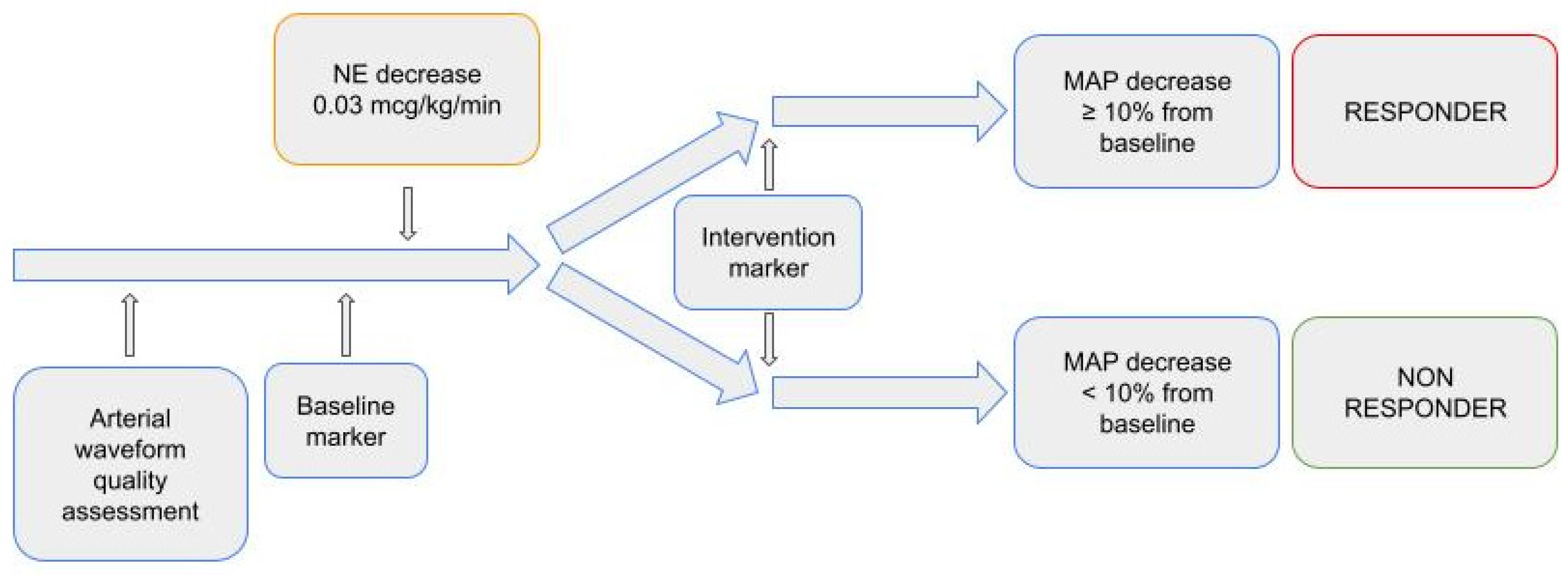
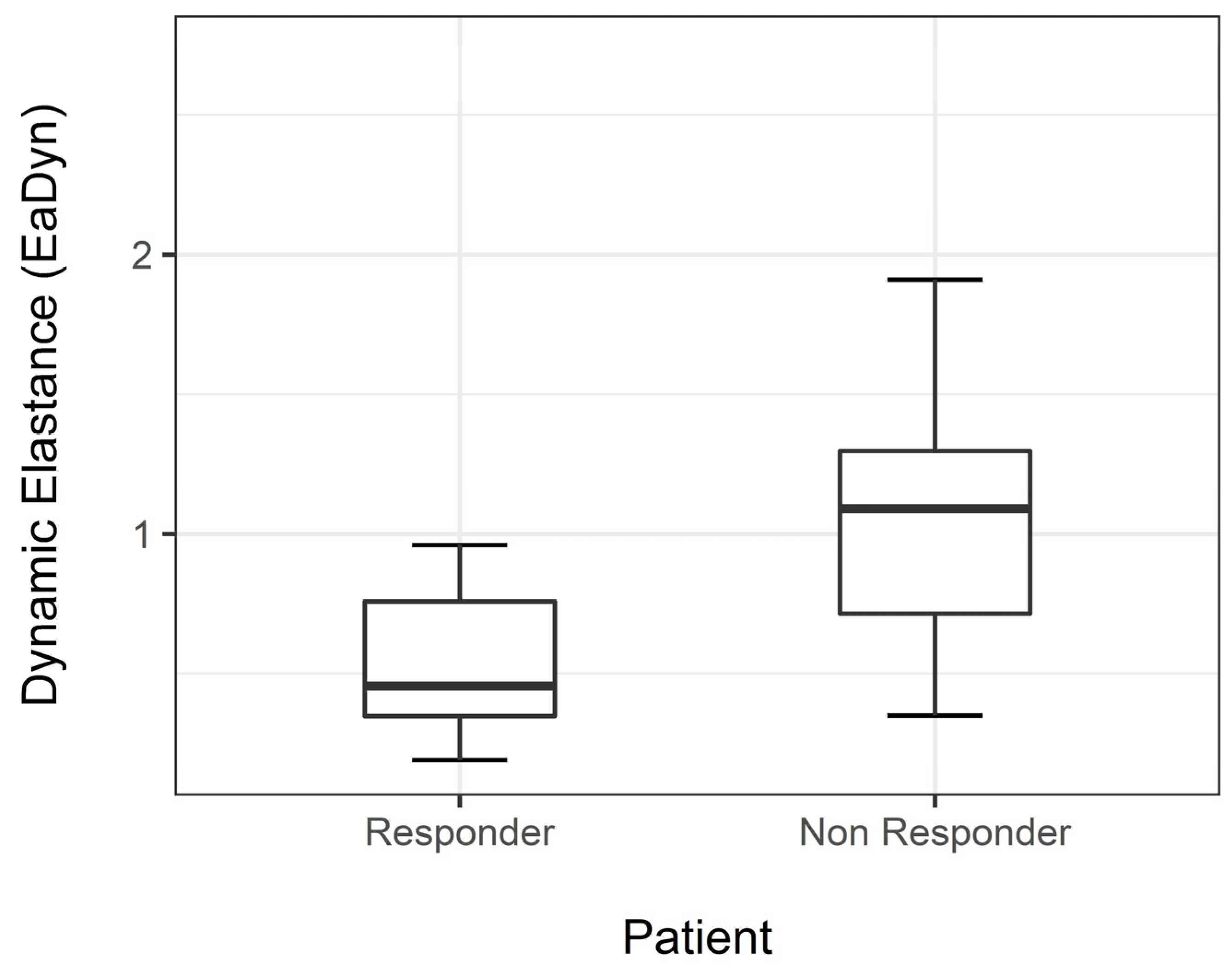
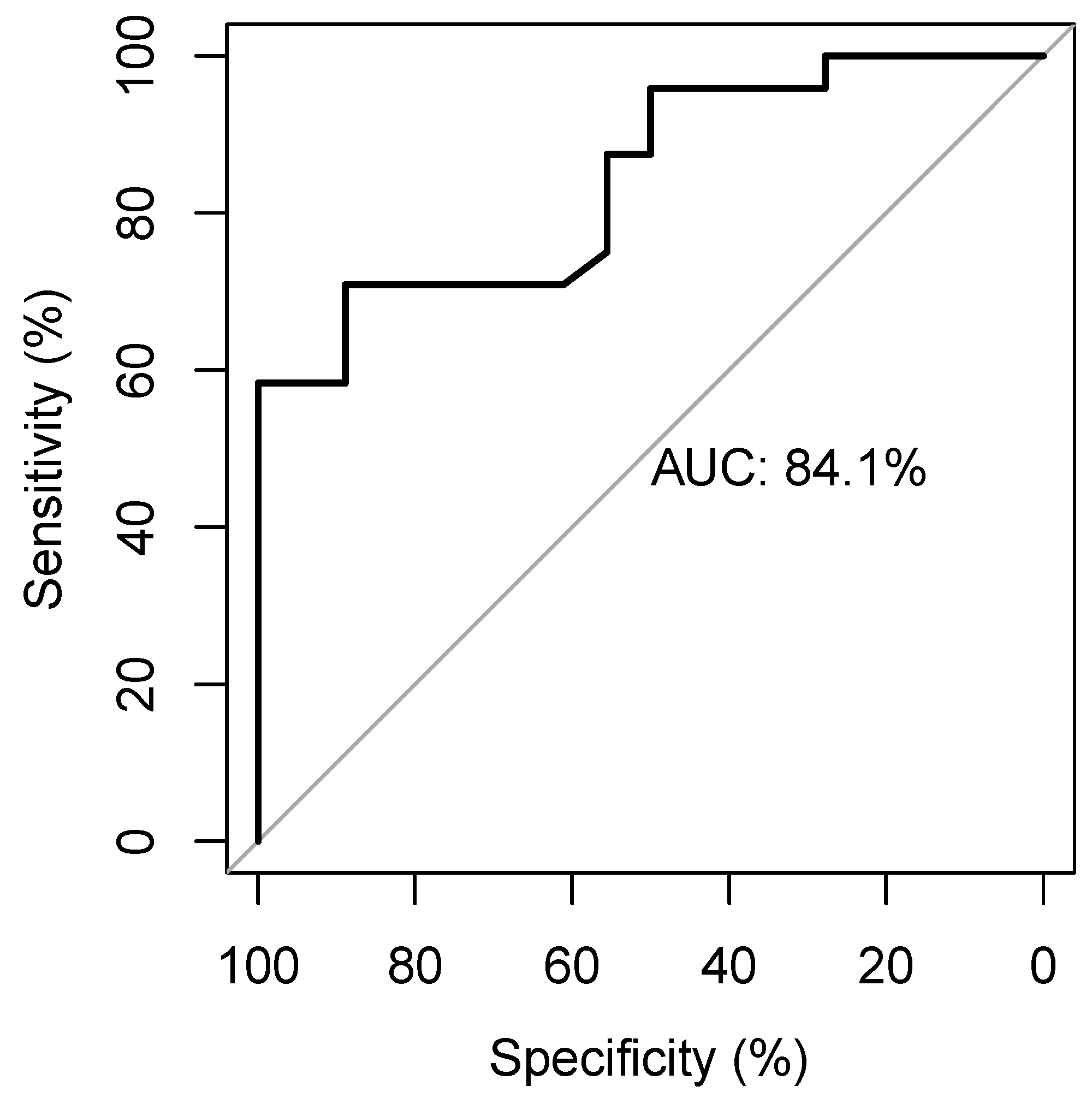
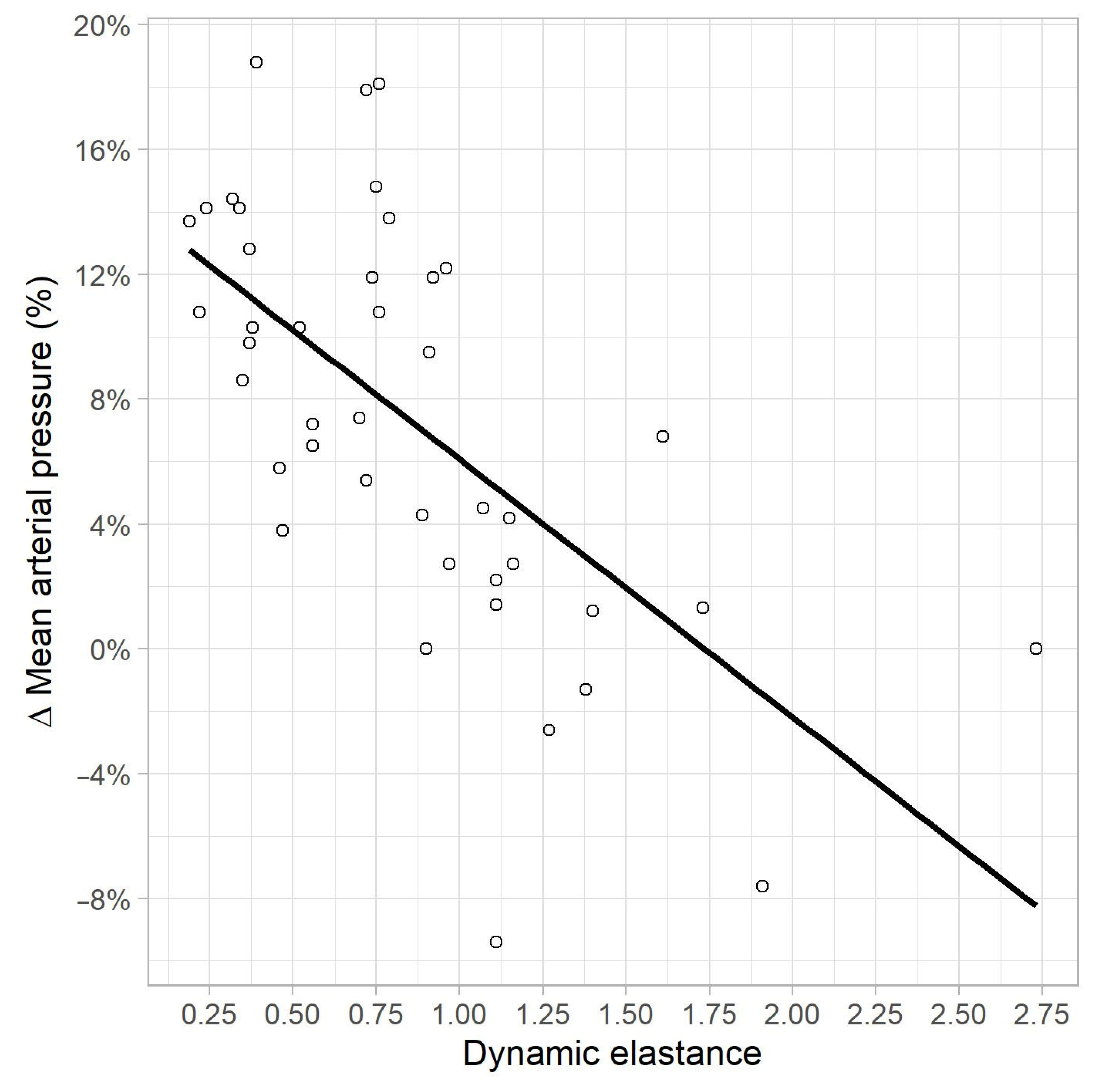
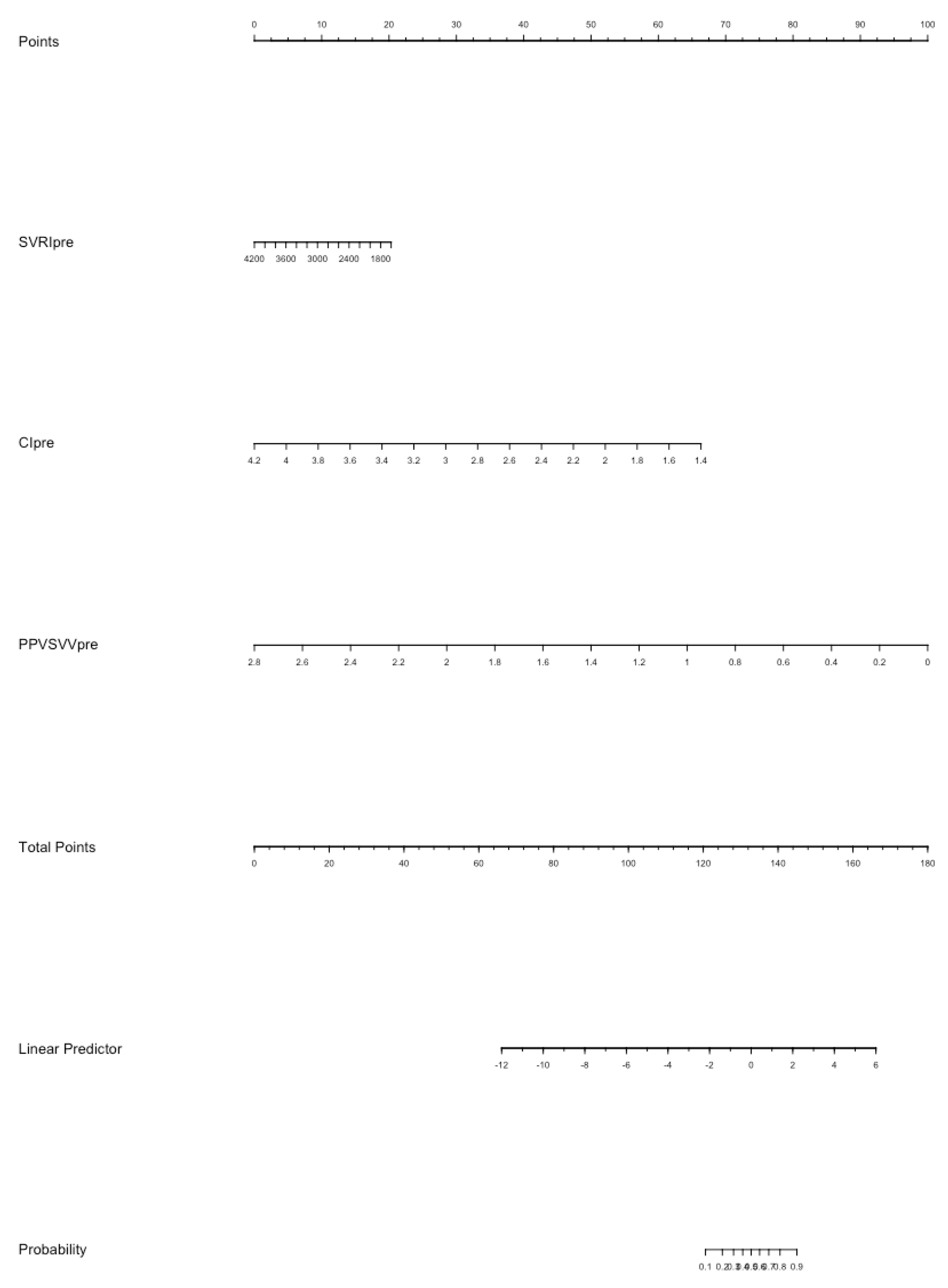
| Variable | Value |
|---|---|
| Age (y.o.) | 57 (47–66) |
| Gender (F/M) (%) | 10/22 (31/69) |
| BMI (Kg/m2) | 26.1 (21.4–29.4) |
| BSA (m2) | 1.9 (1.6–2.0) |
| SOFA score | 10 (9–12) |
| Vt/PBW (mL/Kg) | 7.5 (7.2–8.0) |
| Arterial hypertension (%) | 38 |
| Diabetes mellitus (%) | 26 |
| Source of septic shock (%) | |
| Pulmonary | 23 (72) |
| Abdominal | 6 (19) |
| Other | 3 (9) |
| Pre | Post | |
|---|---|---|
| Heart rate (bpm) | ||
| Responders | 94 (93–104) | 92 (91–102) |
| Non-responders | 78 (70–100) | 78 (68–95) |
| Systolic blood pressure (mmHg) | ||
| Responders | 127 (117–137) | 107 (101–114) * |
| Non-responders | 127 (113–134) | 125 (111–131) |
| Mean arterial pressure (mmHg) | ||
| Responders | 72 (71–85) | 64 (63–74) * |
| Non-responders | 79 (76–92) | 79 (73–91) |
| Systolic volume (mL) | ||
| Responders | 46 (37–52) | 33 (31–40) |
| Non-responders | 60 (40–67) | 58 (42–68) |
| Cardiac output (L/min) | ||
| Responders | 4.3 (3.8–4.8) | 3.2 (3.1–3.7) |
| Non-responders | 4.4 (3.9–4.7) | 4.4 (4.0–4.5) |
| Systemic vascular resistances indexed (dynes × s/cm5) | ||
| Responders | 1407 (1300–1489) | 1413 (1387–1423) |
| Non-responders | 1316 (1277–1483) | 1307 (1274–1422) |
| Stroke volume variation (%) | ||
| Responders | 18 (15–18) | 13 (10–14) |
| Non-responders | 10 (6–13) | 8 (6–12) |
| Pulse pressure variation (%) | ||
| Responders | 6 (4–7) | 9 (8–10) * |
| Non-responders | 6 (5–11) | 6 (5–11) |
| dP/dt (mmHg/ms) | ||
| Responders | 1.36 (1.19–1.39) | 0.88 (0.82–0.95) |
| Non-responders | 1.03 (1.01–1.06) | 1.01 (0.98–1.08) |
| Norepinephrine infusion velocity (mcg/Kg/min) | ||
| Responders | 0.14 (0.1–0.2) | 0.1 (0.06–0.16) * |
| Non-responders | 0.14 (0.09–0.2) | 0.1 (0.06–0.17) * |
Disclaimer/Publisher’s Note: The statements, opinions and data contained in all publications are solely those of the individual author(s) and contributor(s) and not of MDPI and/or the editor(s). MDPI and/or the editor(s) disclaim responsibility for any injury to people or property resulting from any ideas, methods, instructions or products referred to in the content. |
© 2022 by the authors. Licensee MDPI, Basel, Switzerland. This article is an open access article distributed under the terms and conditions of the Creative Commons Attribution (CC BY) license (https://creativecommons.org/licenses/by/4.0/).
Share and Cite
Persona, P.; Tonetti, T.; Valeri, I.; Pivetta, E.; Zarantonello, F.; Pettenuzzo, T.; De Cassai, A.; Navalesi, P. Dynamic Arterial Elastance to Predict Mean Arterial Pressure Decrease after Reduction of Vasopressor in Septic Shock Patients. Life 2023, 13, 28. https://doi.org/10.3390/life13010028
Persona P, Tonetti T, Valeri I, Pivetta E, Zarantonello F, Pettenuzzo T, De Cassai A, Navalesi P. Dynamic Arterial Elastance to Predict Mean Arterial Pressure Decrease after Reduction of Vasopressor in Septic Shock Patients. Life. 2023; 13(1):28. https://doi.org/10.3390/life13010028
Chicago/Turabian StylePersona, Paolo, Tommaso Tonetti, Ilaria Valeri, Emanuele Pivetta, Francesco Zarantonello, Tommaso Pettenuzzo, Alessandro De Cassai, and Paolo Navalesi. 2023. "Dynamic Arterial Elastance to Predict Mean Arterial Pressure Decrease after Reduction of Vasopressor in Septic Shock Patients" Life 13, no. 1: 28. https://doi.org/10.3390/life13010028
APA StylePersona, P., Tonetti, T., Valeri, I., Pivetta, E., Zarantonello, F., Pettenuzzo, T., De Cassai, A., & Navalesi, P. (2023). Dynamic Arterial Elastance to Predict Mean Arterial Pressure Decrease after Reduction of Vasopressor in Septic Shock Patients. Life, 13(1), 28. https://doi.org/10.3390/life13010028








